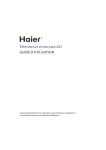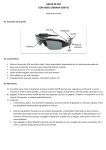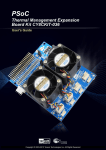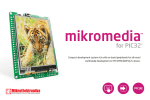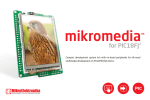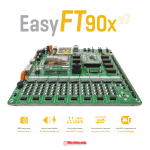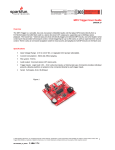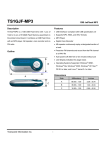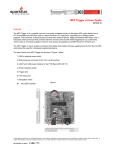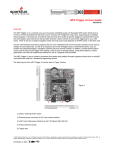Download mikromedia for PSoC 5LP Manual
Transcript
mikromedia for PSoC 5LP ™ ® Compact development system rich with on-board peripherals for all-round multimedia development on CY8C5868AXI-LP035 device. PSoC TO OUR VALUED CUSTOMERS I want to express my thanks to you for being interested in our products and for having confidence in MikroElektronika. The primary aim of our company is to design and produce high quality electronic products and to constantly improve the performance thereof in order to better suit your needs. Nebojsa Matic General Manager The PSoC® and Windows® logos and product names are trademarks of Cypress® and Microsoft® in the U.S.A. and other countries. Table of Contents Introduction to mikromedia for PSoC® 5LP 4 4. Reset Button 18 Package Contains 5 5. Crystal oscillator 20 Key Features 6 6. microSD Card Slot 22 7 7. Touch Screen 24 8 8. Audio Module 26 Battery power supply 8 9. USB connection 28 USB power supply 8 10. Accelerometer 30 System Specification 1. Power supply 2. CY8C5868AXI-LP035 microcontroller 10 11. FRAM 32 Key microcontroller features 10 12. Pads 34 3. Programming the microcontroller 11 13. Pinout 35 Programming with PSoC® Bootloader 12 14. Dimensions 36 37 PSoC Creator Installation Wizard 13 15. mikromedia accessories PSoC® Programmer™ Installation wizard 14 Notes38 PSoC® bootloader quick guide 15 Disclaimer39 ® ™ Programming with mikroProg™16 Page 3 Introduction to mikromedia for PSoC® 5LP The mikromedia for PSoC® 5LP is a compact development system with lots of on-board peripherals which allow development of devices with multimedia content. The central part of the system is a 32-bit CY8C5868AXI-LP035 microcontroller. The mikromedia for PSoC® 5LP features integrated modules such as stereo MP3 codec, 320x240 TFT touch screen display, accelerometer, USB connector, audio connector, MMC/SD card slot, 2Mbit FRAM, two 1x26 connection pads and other. It comes preprogrammed with a USB HID PSoC® bootloader, but can also be programmed with external programmers, such as mikroProg™ for PSoC® 5LP or other external programmers. Mikromedia is compact and slim which makes it a convenient platform for mobile devices. Page 4 Package Contains 01 04 Damage resistant protective box 02 mikromedia for PSoC® 5LP user’s guide 05 mikromedia for PSoC® 5LP development board mikromedia™ for PSoC® 5LP schematics and pinout Page 5 03 Two 1x26 male headers and one 2x5 male headers 06 USB cable Key Features 09 01 Connection Pads 02 TFT display 320x240px 03 USB MINI-B connector 04 CHARGE indicator LED 05 Li-Polymer battery connector 01 06 3.5mm headphone connector 07 Power supply regulator 08 FRAM 09 RESET button 10 VS1053 Stereo mp3 coder/decoder 11 CY8C5868AXI-LP035 microcontroller 12 Accelerometer 02 13 Crystal oscillator 14 Power indication LED 15 microSD Card Slot 16 mikroProg connector 17 Cortex Debug connector Page 6 04 03 05 14 06 System Specification 07 power supply Via USB cable (5V DC) 10 power consumption 46 mA with erased MCU (when on-board modules are inactive) 13 11 board dimensions 12 81.2 x 60.5 mm (3.19 x 2.38 inch) weight ~50g (0.11lbs) 08 15 17 16 Page 7 1. Power supply USB power supply You can power the board using the MINI-B USB cable which comes in the package. On-board voltage regulators provide the appropriate voltage levels to each component on the board. Power LED (GREEN) will indicate the presence of power supply. Figure 1-1: Connecting USB power supply Battery power supply You can also power the board using a Li-Polymer battery, via on-board battery connector. On-board battery charger circuit MCP73832 enables you to charge the battery over USB connection. LED diode (RED) will indicate when the battery is charging. Charging current is ~250mA and charging voltage is 4.2V DC. Figure 1-2: Connecting Li-Polymer battery Page 8 VCC-USB CN5 C42 GNDA VCC-SYS 1 2 3 4 5 R45 100K VBUS DD+ ID GND HDR1 1 2 3 4 5 6 7 8 9 10 11 12 13 14 15 16 17 18 19 20 21 22 23 24 25 26 1 2 J2 NetTie USB MINIB GNDA GND VCC-BAT VCC-3.3V R31 100K R35 100K VCC-BAT 10K CN4 BATT CONN R38 10K BAT-STAT 2.2uF R37 4K7 1 2 3 D1 PMEG3010ER M1 DMP2160UW VCC-BAT VCC-3.3V VCC-3.3V C34 E4 10uF U5 Vin GND EN Vout ADJ 5 R26 100K 4 AP7331-ADJ VCC-SYS R29 27K4 R30 1K VCC-3.3V LD1 CHARGE Q4 BC846 VCC-3.3V VCC-BAT R39 10K VCC-SYS E7 10uF Q5 BC846 R41 1K R43 R42 10K 10K E8 10uF 1 2 3 VCC-3.3V R33 100K VSENSE VCC-1.8V VCC-USB R34 VCC-3.3V DATA BUS FP3 FERRITE C41 VCC-3.3V 2.2uF U6 STAT PROG VSS VBAT VDD 5 4 MCP73832 R46 3K9 LD2 POWER Charging Current approx. 250mA Figure 1-3: Power supply schematics Page 9 VCC-SYS VCC-3.3V 1 R47 2K2 3 E9 10uF REG1 Vin Vout GND 2 E10 LD29080DT33 10uF HDR2 27 28 29 30 31 32 33 34 35 36 37 38 39 40 41 42 43 44 45 46 47 48 49 50 51 52 2. CY8C5868AXI-LP035 microcontroller Clocking Sy stem Digital Syste m Universal Dig ital Block Array (24x UDB) IMO RTC Timer Key microcontroller features WDT and Wake ILO - 64 MHz, 32-bit ARM Cortex -M3 Core; ® ™ SIOs - 62 I/O pins; stem EMIF - 256 KB Flash; 64 KB SRAM; - 4 dedicated comparators Memory Sy EEPROM Power Mgmt . System POR and LVD Sleep Power 1.8 V LDO - SPI, I2C, UART, CAN, USB, ADC, DAC; SMP - Timers, counters, PWMs; - Internal Oscillators; - RTCC; etc. Page 10 CPU System SRAM Cortex M3PU FLASH Cache Controller Analog Syste m LCD Direct Digital Drive Filter Block 4x SC/CT Blo cks Temp. Sensor CapSense I2C CAN 2.0 Master/ Slave 4x Timer Counter FS US 2.0 PWM USB PHY Interrupt Controller PHUB DMA SIOs GPIOs Xtal Osc Program & Debug Program Debug Boundary SCan 4x AMP ADCs 4x DAC 4x CMP GPIOs The mikromedia for PSoC® 5LP development system comes with the CY8C5868AXI-LP035 microcontroller. This highperformance 32-bit microcontroller with its integrated analog and digital modules and in combination with other on-board modules is ideal for multimedia applications. 3. Programming the microcontroller Figure 3-1: CY8C5868AXI-LP035 microcontroller The microcontroller can be programmed in two ways: 01 Over USB HID PSoC® bootloader 02 Using mikroProg™ for PSoC® 5LP or other external programmers. Page 11 Programming with PSoC® Bootloader You can program the microcontroller with the bootloader which is preprogrammed into the device by default. To transfer the bootloader file from PC to MCU you need PSoC® Programmer™ and PSoC® Creator™. Appropriate software packages can be found on the links bellow. Before downloading software you need to register on Cypress’ website. http://www.cypress.com/?rID=38050 http://www.cypress.com/psoccreator/ Upon download, double click each setup file to begin installation of the PSoC® Programmer and PSoC® Creator™. Figure 3-2: Main Window of PSoC® Creator™ software Page 12 PSoC® Creator™ Installation Wizard 01 Start Installation 02 Installation type 03 Accept license agreement 04 Accept license agreement 05 Installation in progress 06 Finish installation Page 13 PSoC® Programmer™ Installation wizard 01 Start Installation 02 Setup 03 Installation type 04 Accept license agreement 05 Installation in progress 06 Finish installation Page 14 PSoC® bootloader quick guide 02 NOTE: Prior to use, bootloader .HEX file needs to be programmed into the mikromedia for PSoC® 5LP’s MCU. Start PSoC® Creator™ and open the appropriate Workspace File for PSoC® Creator™ (.cywrk file): 03 01 01 Double click the Bootloadable component and the Configure window will appear. 02 Click the Dependencies tab to find a reference Figure 3-3: PSoC® bootloader host to the associated bootloader .HEX and .ELF files. 03 Click the Browse button and choose the Bootloader_USBFS.HEX file from the pop-up window. The file can be find in the bootloader example folder. Click the OK button. 06 04 Open PSoC® Creator™ Bootloader Host window (Tools > Bootloader Host): 04 Click the blue folder icon and choose the .CYACD file which will be uploaded to MCU memory 05 from the pop-up window. 05 Connect the USB cable, or if already connected press the Reset button on your mikromedia board. USB Human Interface Device will appear in the Ports section of the window. 06 Click the blue arrow icon within 10s to program the MCU memory, otherwise the existing microcontroller program will execute. 07 If everything is done properly the board will automatically reset and your new program will execute. Page 15 07 Figure 3-4: PSoC® bootloader host Programming with mikroProg™ programmer The microcontroller can be programmed with the mikroProg™ for PSoC® 5LP programmer, PSoC® programmer™ software and PSoC® Creator™ software. The mikroProg™ is connected to the development board via the CN6 connector, Figure 3-5. The board also contains a Cortex Debug connector (CN3) which can be used with other external programmers. mikroProg™ for PSoC® 5LP is a fast programmer and hardware debugger. It’s a great tool for programming the Cypress® PSoC® 5LP microcontroller family. Outstanding performance, easy operation, elegant design and affordable price are its top features. Figure 3-5: Connecting mikroProg™ to mikromedia™ Page 16 VCC-3.3V 100 99 98 97 96 95 94 93 92 91 90 89 88 87 86 85 84 83 82 81 80 79 78 77 76 VCCD 2 4 6 8 10 TMS/SWDIO TCK/SWDCK TDO/SWV TDI RESET# RESET# VCC-3.3V 1 3 5 7 9 2 4 6 8 10 CN3 TMS/SWDIO TCK/SWDCK TDO/SWV TDI RESET# TMS/SWDIO TCK/SWDCK TDO/SWV TDI CY8C5868AXI-LP035 VCC-3.3V 75 74 73 72 71 70 69 68 67 66 65 64 63 62 61 60 59 58 57 56 55 54 53 52 51 VDDA FP1 C6 1uF VDDA C7 100nF GNDA GNDA VCC-3.3V VCCA E6 10uF VCCA VCCA C4 100nF GNDA VCCD XOSCI XOSCO X2 VCCD C10 100nF C5 1uF GNDA VCCD C11 100nF C12 1uF 32.768KHz C2 10pF C3 10pF VCC-3.3V VCC-3.3V VCC-3.3V C13 100nF VCCD C14 100nF C15 100nF OSCO OSCI CN6 VDDIO0 P0[3] P0[2] P0[1] P0[0] P4[1] P4[0] P12[3] P12[2] VSSD VDDA VSSA VCCA NC NC NC NC NC NC P15[3] P15[2] P12[1] P12[0] P3[7] P3[6] VDDIO1 P1[6] P1[7] P12[6] P12[7] P5[4] P5[5] P5[6] P5[7] P15[6] P15[7] VDDD VSSD VCCD NC NC P15[0] P15[1] P3[0] P3[1] P3[2] P3[3] P3[4] P3[5] VDDIO3 1 3 5 7 9 P2[5] P2[6] P2[7] P12[4] P12[5] P6[4] P6[5] P6[6] P6[7] VSSB IND VBOOST VBAT VSSD XRES P5[0] P5[1] P5[2] P5[3] P1[0] P1[1] P1[2] P1[3] P1[4] P1[5] 26 27 28 29 30 31 32 33 34 35 36 37 38 39 40 41 42 43 44 45 46 47 48 49 50 J TAG/ S WD VCC-3.3V 1 2 3 4 5 6 7 8 9 10 11 12 13 14 15 16 17 18 19 20 21 22 23 24 25 VDDIO2 P2[4] P2[3] P2[2] P2[1] P2[0] P15[5] P15[4] P6[3] P6[2] P6[1] P6[0] VDDD VSSD VCCD P4[7] P4[6] P4[5] P4[4] P4[3] P4[2] P0[7] P0[6] P0[5] P0[4] U1 GNDA X1 VCC-3.3V VCC-3.3V VCC-3.3V VCC-3.3V 16MHz C8 22pF C9 22pF Figure 3-6: mikroProg™ connection schematic Page 17 C16 100nF C17 100nF C18 100nF E1 10uF 4. Reset Button Figure 4-1: Reset button Board is equipped with reset button, which is located at the top of the front side (Figure 4-1). Press it to reset the circuit. It will generate a low voltage level on the microcontroller reset pin (input). In addition, a reset signal can also be sent through pin 27 on side headers (Figure 4-2). Page 18 VCC-3.3V 100 99 98 97 96 95 94 93 92 91 90 89 88 87 86 85 84 83 82 81 80 79 78 77 76 VCCD VDDIO2 P2[4] P2[3] P2[2] P2[1] P2[0] P15[5] P15[4] P6[3] P6[2] P6[1] P6[0] VDDD VSSD VCCD P4[7] P4[6] P4[5] P4[4] P4[3] P4[2] P0[7] P0[6] P0[5] P0[4] 75 74 73 72 71 70 69 68 67 66 65 64 63 62 61 60 59 58 57 56 55 54 53 52 51 VDDIO0 P0[3] P0[2] P0[1] P0[0] P4[1] P4[0] P12[3] P12[2] VSSD VDDA VSSA VCCA NC NC NC NC NC NC P15[3] P15[2] P12[1] P12[0] P3[7] P3[6] CY8C5868AXI-LP035 VDDIO1 P1[6] P1[7] P12[6] P12[7] P5[4] P5[5] P5[6] P5[7] P15[6] P15[7] VDDD VSSD VCCD NC NC P15[0] P15[1] P3[0] P3[1] P3[2] P3[3] P3[4] P3[5] VDDIO3 P2[5] P2[6] P2[7] P12[4] P12[5] P6[4] P6[5] P6[6] P6[7] VSSB IND VBOOST VBAT VSSD XRES P5[0] P5[1] P5[2] P5[3] P1[0] P1[1] P1[2] P1[3] P1[4] P1[5] VCC-3.3V R1 10K RESET# R2 RST 1K T1 C1 100nF VDDA VCCA XOSCI XOSCO VCC-3.3V X2 RX TX SCL SDA 32.768KHz C2 10pF C3 10pF 26 27 28 29 30 31 32 33 34 35 36 37 38 39 40 41 42 43 44 45 46 47 48 49 50 VCC-3.3V VCCD VCC-3.3V OSCO OSCI RESET# 1 2 3 4 5 6 7 8 9 10 11 12 13 14 15 16 17 18 19 20 21 22 23 24 25 HDR2 27 28 29 30 31 32 33 34 35 36 37 38 39 40 41 42 43 44 45 46 47 48 49 50 51 52 RST U1 GNDA E6 10uF X1 16MHz C8 22pF VCCA VCCA C4 100nF GNDA C9 22pF VCCD VCCD C10 100nF VCCD C11 100nF FP1 C6 1uF C5 1uF GNDA GNDA C7 100nF GNDA VCC-3.3V VCC-3.3V VCC-3.3V VCC-3.3V VCC-3.3V VCC-3.3V VCC-3.3V C12 1uF Figure 4-2: Reset circuit schematic Page 19 VDDA C13 100nF C14 100nF C15 100nF C16 100nF C17 100nF C18 100nF E1 10uF 5. Crystal oscillator Figure 5-1: External crystal oscillator (X1) Board is equipped with a 16MHz crystal oscillator (X1) circuit that provides external clock waveform to the microcontroller OSCO and OSCI pins. This base frequency is suitable for further clock multipliers and ideal for generation of necessary USB clock, which ensures proper operation of bootloader and your custom USB-based applications. The board also contains a 32.768kHz Crystal oscillator (X2) which provides external clock for internal RTCC module. NOTE : The use of crystal in all other schematics is implied even if it is purposely left out because of the schematic’s clarity. Page 20 VCC-3.3V VCCD VCC-3.3V VDDA 100 99 98 97 96 95 94 93 92 91 90 89 88 87 86 85 84 83 82 81 80 79 78 77 76 FP1 C6 1uF VDDIO0 P0[3] P0[2] P0[1] P0[0] P4[1] P4[0] P12[3] P12[2] VSSD VDDA VSSA VCCA NC NC NC NC NC NC P15[3] P15[2] P12[1] P12[0] P3[7] P3[6] CY8C5868AXI-LP035 VDDIO1 P1[6] P1[7] P12[6] P12[7] P5[4] P5[5] P5[6] P5[7] P15[6] P15[7] VDDD VSSD VCCD NC NC P15[0] P15[1] P3[0] P3[1] P3[2] P3[3] P3[4] P3[5] VDDIO3 P2[5] P2[6] P2[7] P12[4] P12[5] P6[4] P6[5] P6[6] P6[7] VSSB IND VBOOST VBAT VSSD XRES P5[0] P5[1] P5[2] P5[3] P1[0] P1[1] P1[2] P1[3] P1[4] P1[5] 75 74 73 72 71 70 69 68 67 66 65 64 63 62 61 60 59 58 57 56 55 54 53 52 51 C7 100nF GNDA GNDA VCC-3.3V VCCA E6 10uF VCCA C4 100nF GNDA VDDA VCCD VCCA VCCD C10 100nF C5 1uF GNDA VCCD C11 100nF C12 1uF XOSCI XOSCO X2 VCC-3.3V VCC-3.3V VCC-3.3V 32.768KHz C2 10pF C13 100nF C3 10pF C14 100nF C15 100nF 26 27 28 29 30 31 32 33 34 35 36 37 38 39 40 41 42 43 44 45 46 47 48 49 50 VCC-3.3V VCC-3.3V VCC-3.3V VCC-3.3V VCCD OSCO OSCI 1 2 3 4 5 6 7 8 9 10 11 12 13 14 15 16 17 18 19 20 21 22 23 24 25 VDDIO2 P2[4] P2[3] P2[2] P2[1] P2[0] P15[5] P15[4] P6[3] P6[2] P6[1] P6[0] VDDD VSSD VCCD P4[7] P4[6] P4[5] P4[4] P4[3] P4[2] P0[7] P0[6] P0[5] P0[4] U1 C16 100nF GNDA X1 16MHz C8 22pF C9 22pF Figure 5-2: Crystal oscillator schematic Page 21 C17 100nF C18 100nF E1 10uF 6. microSD Card Slot Figure 6-1: microSD card slot Board contains microSD card slot for using microSD cards in your projects. It enables you to store large amounts of data externally, thus saving microcontroller’s memory. microSD cards use Serial Peripheral Interface (SPI) for communication with the microcontroller. Page 22 VCC-MMC VCC-3.3V FP2 VCC-3.3V VCCD FERRITE 100 99 98 97 96 95 94 93 92 91 90 89 88 87 86 85 84 83 82 81 80 79 78 77 76 C43 1uF P2[5] P2[6] P2[7] P12[4] P12[5] P6[4] P6[5] P6[6] P6[7] VSSB IND VBOOST VBAT VSSD XRES P5[0] P5[1] P5[2] P5[3] P1[0] P1[1] P1[2] P1[3] P1[4] P1[5] VDDIO0 P0[3] P0[2] P0[1] P0[0] P4[1] P4[0] P12[3] P12[2] VSSD VDDA VSSA VCCA NC NC NC NC NC NC P15[3] P15[2] P12[1] P12[0] P3[7] P3[6] CY8C5868AXI-LP035 VCCD 75 74 73 72 71 70 69 68 67 66 65 64 63 62 61 60 59 58 57 56 55 54 53 52 51 R27 10K 1 2 4 5 6 7 SPI-SCK R32 SPI-MISO VDDA CN2 R28 10K SD-CS# SPI-MOSI 27 SD-CD# CS Din +3.3V SCK GND Dout CD VCCA MMC CARD MICRO XOSCI XOSCO VCC-3.3V X2 VCC-3.3V 32.768KHz C2 10pF C3 10pF VCCA E6 10uF VCCA C4 100nF GNDA VCCD GNDA X1 VCCD C10 100nF VCCD C11 100nF C12 1uF FP1 C6 1uF C5 1uF GNDA C7 100nF GNDA VCC-3.3V VCC-3.3V VCC-3.3V VCC-3.3V VCC-3.3V VCC-3.3V VCC-3.3V C13 100nF C14 100nF C9 22pF Figure 6-2: microSD card slot module connection schematic Page 23 VDDA GNDA 16MHz C8 22pF E5 10uF GND 1 2 3 4 5 6 7 8 9 10 11 12 13 14 15 16 17 18 19 20 21 22 23 24 25 OSCO OSCI 27 VDDIO1 P1[6] P1[7] P12[6] P12[7] P5[4] P5[5] P5[6] P5[7] P15[6] P15[7] VDDD VSSD VCCD NC NC P15[0] P15[1] P3[0] P3[1] P3[2] P3[3] P3[4] P3[5] VDDIO3 SD-CD# SD-CS# 27 C40 100nF VCC-MMC 26 27 28 29 30 31 32 33 34 35 36 37 38 39 40 41 42 43 44 45 46 47 48 49 50 SPI-SCK R49 SPI-MISO SPI-MOSI R50 VDDIO2 P2[4] P2[3] P2[2] P2[1] P2[0] P15[5] P15[4] P6[3] P6[2] P6[1] P6[0] VDDD VSSD VCCD P4[7] P4[6] P4[5] P4[4] P4[3] P4[2] P0[7] P0[6] P0[5] P0[4] U1 C15 100nF C16 100nF C17 100nF C18 100nF E1 10uF 7. Touch Screen The development system features a TFT 320x240 display (MI0283QT-9A) covered with a resistive touch panel. Together they form a functional touch screen unit. It enables data to be entered and displayed at the same time. The TFT display is capable of showing graphics in 262.144 different colors. Figure 7-1: Touch Screen Page 24 LCD-D4 LCD-D5 LCD-D6 LCD-D7 LCD-D0 LCD-D1 LCD-D2 LCD-D3 R19 10K VCC-3.3V VCCD Q1 BC846 100 99 98 97 96 95 94 93 92 91 90 89 88 87 86 85 84 83 82 81 80 79 78 77 76 LCD-BLED VCC-SYS VCC-3.3V BLED- VCC-3.3V LCD-XL LCD-BLED R20 1K Q2 BC846 VDDA LCD-D7 LCD-D6 LCD-D5 LCD-D4 LCD-D3 LCD-D2 LCD-D1 LCD-D0 Q3 BC846 VCCA VCC-3.3V XOSCI XOSCO C44 X2 10uF LCD-RD# LCD-WR# LCD-RS LCD-CS# 32.768KHz C2 10pF VCCD OSCO OSCI LCD-YD CY8C5868AXI-LP035 VDDIO1 P1[6] P1[7] P12[6] P12[7] P5[4] P5[5] P5[6] P5[7] P15[6] P15[7] VDDD VSSD VCCD NC NC P15[0] P15[1] P3[0] P3[1] P3[2] P3[3] P3[4] P3[5] VDDIO3 LCD-WR# LCD-RS LCD-CS# LCD-XR 75 74 73 72 71 70 69 68 67 66 65 64 63 62 61 60 59 58 57 56 55 54 53 52 51 VDDIO0 P0[3] P0[2] P0[1] P0[0] P4[1] P4[0] P12[3] P12[2] VSSD VDDA VSSA VCCA NC NC NC NC NC NC P15[3] P15[2] P12[1] P12[0] P3[7] P3[6] R21 10K LCD-RST R25 12 C3 10pF R36 10K 26 27 28 29 30 31 32 33 34 35 36 37 38 39 40 41 42 43 44 45 46 47 48 49 50 LCD-RD# P2[5] P2[6] P2[7] P12[4] P12[5] P6[4] P6[5] P6[6] P6[7] VSSB IND VBOOST VBAT VSSD XRES P5[0] P5[1] P5[2] P5[3] P1[0] P1[1] P1[2] P1[3] P1[4] P1[5] LCD-YU LCD-RST 1 2 3 4 5 6 7 8 9 10 11 12 13 14 15 16 17 18 19 20 21 22 23 24 25 VDDIO2 P2[4] P2[3] P2[2] P2[1] P2[0] P15[5] P15[4] P6[3] P6[2] P6[1] P6[0] VDDD VSSD VCCD P4[7] P4[6] P4[5] P4[4] P4[3] P4[2] P0[7] P0[6] P0[5] P0[4] U1 LCD-XR LCD-YD LCD-XL LCD-YU GNDA X1 TFT1 1 2 3 4 5 6 7 8 9 10 11 12 13 14 15 16 17 18 19 20 21 22 23 24 25 26 27 28 29 30 31 32 33 34 35 36 37 38 39 40 41 42 43 44 45 46 47 LED-K LED-A1 LED-A2 LED-A3 LED-A4 IM0 IM3 IM2 IM1 RESET VSYNC HSYNC DOTCLK ENABLE DB17 DB16 DB15 DB14 DB13 DB12 DB11 DB10 DB9 DB8 DB7 DB6 DB5 DB4 DB3 DB2 DB1 DB0 SDO SDI RD WR RS CS TE VCC-IO VCC VCC GND XR YD XL YU MI0283QT-9A 16MHz C8 22pF C9 22pF VCC-3.3V VCC-3.3V E6 10uF VCCA VCCA C4 100nF GNDA VCCD VDDA C5 1uF GNDA VCCD VCCD VCC-3.3V VCC-3.3V VCC-3.3V VCC-3.3V VCC-3.3V VCC-3.3V VCC-3.3V FP1 C6 1uF GNDA C7 100nF C10 100nF C11 100nF C12 1uF GNDA Figure 7-2: Touch Screen connection schematic Page 25 C13 100nF C14 100nF C15 100nF C16 100nF C17 100nF C18 100nF E1 10uF 8. Audio Module Figure 8-1: On-board VS1053 MP3 codec The mikromedia for PSoC® 5LP features stereo audio codec VS1053. This module enables audio reproduction through stereo headphones connected to the system via a 3.5mm connector CN1. All functions of this module are controlled by the microcontroller over Serial Peripheral Interface (SPI). Page 26 VCC-3.3V R5 E2 10uF 470 U1 12 11 10 9 8 7 6 5 4 3 2 1 22pF 12.288 MHz X3 C26 R14 1M R15 10K VDDA 22pF MP3-CS# XDCS/BSYNC IOVDD1 VC0 DGND1 XTAL0 XTAL1 IOVDD2 DGND2 DGND3 DGND4 XCS CVDD2 VS1053 XOSCI XOSCO X2 MP3-DREQ MP3-RST# 32.768KHz C3 10pF R22 10K R23 27 R24 10K GBUF 10 RIGHT R13 10 C24 1uF R16 10 R17 10 R51 10 R52 10 C27 10nF R18 10 C29 47nF C28 10nF C35 C36 C37 C38 C39 C45 100nF 100nF 100nF 100nF 100nF 1uF MP3-CS# MP3-DCS VCC-3.3V X1 VCCD VCCD C9 22pF C10 100nF VCCD C11 100nF C12 1uF VCC-3.3V VCC-3.3V VCC-3.3V VCC-3.3V VCC-3.3V VCC-3.3V VCC-3.3V C13 100nF C14 100nF C15 100nF C16 100nF C17 100nF C18 100nF E1 10uF VCC-3.3V VCCA E6 10uF VCCA C4 100nF GNDA Figure 8-2: Audio module connection schematic Page 27 VDDA C5 1uF GNDA CN1 PHONEJACK RIGHT GNDA 16MHz L R9 100K R11 LEFT LEFT VCC-3.3V VCC-3.3V VCC-3.3V VCC-3.3V VCC-3.3V VCC-3.3V SPI-SCK SPI-MOSI SPI-MISO C2 10pF VCCD C8 22pF 48 47 46 45 44 43 42 41 40 39 38 37 LN2 AGND3 LEFT AVDD2 RCAP AVDD1 GBUF AGND2 AGND1 RIGHT AVDD0 AGND0 GPIO5 RX TX SCLK SI SO CVDD3 XTEST GPIO0 GPIO1 GND GPIO4 VCCA 13 14 15 16 17 18 19 20 21 22 23 24 GPIO7 GPIO6 GPIO3 GPIO2 DREQ CVDD1 IOVDD0 CVDD0 DGND0 XRESET MICN MCP/LN1 MP3-DCS C25 E3 10uF C23 3.3nF 25 26 27 28 29 30 31 32 33 34 35 36 CY8C5868AXI-LP035 R8 470 U3 75 74 73 72 71 70 69 68 67 66 65 64 63 62 61 60 59 58 57 56 55 54 53 52 51 VDDIO0 P0[3] P0[2] P0[1] P0[0] P4[1] P4[0] P12[3] P12[2] VSSD VDDA VSSA VCCA NC NC NC NC NC NC P15[3] P15[2] P12[1] P12[0] P3[7] P3[6] GPIO VDDIO2 P2[4] P2[3] P2[2] P2[1] P2[0] P15[5] P15[4] P6[3] P6[2] P6[1] P6[0] VDDD VSSD VCCD P4[7] P4[6] P4[5] P4[4] P4[3] P4[2] P0[7] P0[6] P0[5] P0[4] P2[5] P2[6] P2[7] P12[4] P12[5] P6[4] P6[5] P6[6] P6[7] VSSB IND VBOOST VBAT VSSD XRES P5[0] P5[1] P5[2] P5[3] P1[0] P1[1] P1[2] P1[3] P1[4] P1[5] OSCO OSCI 27 1 2 3 4 5 6 7 8 9 10 11 12 13 14 15 16 17 18 19 20 21 22 23 24 25 VDDIO1 P1[6] P1[7] P12[6] P12[7] P5[4] P5[5] P5[6] P5[7] P15[6] P15[7] VDDD VSSD VCCD NC NC P15[0] P15[1] P3[0] P3[1] P3[2] P3[3] P3[4] P3[5] VDDIO3 27 26 27 28 29 30 31 32 33 34 35 36 37 38 39 40 41 42 43 44 45 46 47 48 49 50 SPI-SCK R49 SPI-MISO SPI-MOSI R50 R R7 100K C21 3.3nF 100 99 98 97 96 95 94 93 92 91 90 89 88 87 86 85 84 83 82 81 80 79 78 77 76 R6 10K MP3-RST# MP3-DREQ VCC-1.8V VCC-3.3V VCCD FP1 C6 1uF GNDA C7 100nF GNDA VCC-1.8V VCC-1.8V VCC-1.8V VCC-1.8V C30 C31 C32 C33 100nF 100nF 100nF 100nF 9. USB connection Figure 9-1: Connecting USB cable to MINI-B USB connector CY8C5868AXI-LP035 microcontroller has an integrated USB module connected to a MINI-B USB connector on your mikromedia. It can be used to connect the target USB host device, such as a PC, to your board. Page 28 VCCD VCC-3.3V 100 99 98 97 96 95 94 93 92 91 90 89 88 87 86 85 84 83 82 81 80 79 78 77 76 VCC-USB USB-DET USB-D_N USB-D_P VDDIO0 P0[3] P0[2] P0[1] P0[0] P4[1] P4[0] P12[3] P12[2] VSSD VDDA VSSA VCCA NC NC NC NC NC NC P15[3] P15[2] P12[1] P12[0] P3[7] P3[6] CY8C5868AXI-LP035 VDDIO1 P1[6] P1[7] P12[6] P12[7] P5[4] P5[5] P5[6] P5[7] P15[6] P15[7] VDDD VSSD VCCD NC NC P15[0] P15[1] P3[0] P3[1] P3[2] P3[3] P3[4] P3[5] VDDIO3 P2[5] P2[6] P2[7] P12[4] P12[5] P6[4] P6[5] P6[6] P6[7] VSSB IND VBOOST VBAT VSSD XRES P5[0] P5[1] P5[2] P5[3] P1[0] P1[1] P1[2] P1[3] P1[4] P1[5] 75 74 73 72 71 70 69 68 67 66 65 64 63 62 61 60 59 58 57 56 55 54 53 52 51 R44 100K R48 100K CN5 1 2 3 4 5 R45 100K C42 10uF VBUS DD+ ID GND USB MINIB USB-DET VDDA VCCA XOSCI XOSCO X2 32.768KHz C2 10pF C3 10pF 26 27 28 29 30 31 32 33 34 35 36 37 38 39 40 41 42 43 44 45 46 47 48 49 50 VCC-3.3V VCC-3.3V VCCD VCCA E6 10uF GNDA OSCO OSCI USB-D_P USB-D_N 1 2 3 4 5 6 7 8 9 10 11 12 13 14 15 16 17 18 19 20 21 22 23 24 25 VDDIO2 P2[4] P2[3] P2[2] P2[1] P2[0] P15[5] P15[4] P6[3] P6[2] P6[1] P6[0] VDDD VSSD VCCD P4[7] P4[6] P4[5] P4[4] P4[3] P4[2] P0[7] P0[6] P0[5] P0[4] U1 FP3 FERRITE R40 100K VCCA C4 100nF GNDA X1 VCCD VCCD VCCD VDDA FP1 C6 1uF C5 1uF GNDA GNDA C7 100nF GNDA VCC-3.3V VCC-3.3V VCC-3.3V VCC-3.3V VCC-3.3V VCC-3.3V VCC-3.3V 16MHz C8 22pF C9 22pF C10 100nF C11 100nF C12 1uF C13 100nF C14 100nF C15 100nF Figure 9-2: USB module connection schematic Page 29 C16 100nF C17 100nF C18 100nF E1 10uF 10. Accelerometer Figure 10-1: Accelerometer module On-board ADXL345 accelerometer measures acceleration in three axis: x, y and z. Most common use is to determine screen orientation, but there are many other fields of usage. Communication between the accelerometer and the microcontroller is established through I2C interface. You can set the accelerometer address to 0 or 1 by re-soldering the SMD jumper (zero-ohm resistor) to the appropriate position. Jumper is soldered to position 1 by default. Page 30 VCC-3.3V VCC-3.3V 100 99 98 97 96 95 94 93 92 91 90 89 88 87 86 85 84 83 82 81 80 79 78 77 76 VCCD 14 VCC GND Res GND GND VCC SDA ADD Res NC INT2 INT1 I2C-SDA ACC ADDRESS VCC-3.3V 1 2 3 ADXL345 VCCA J1 VCC-3.3V VCC-3.3V C19 100nF C20 100nF VCC-3.3V XOSCI XOSCO E6 10uF X2 32.768KHz C2 10pF C3 10pF VCC-3.3V VCCA VCCA C4 100nF GNDA GNDA X1 13 12 11 10 9 8 VDDA OSCO OSCI VCCD U2 SCL 1 2 3 4 5 6 CS 75 74 73 72 71 70 69 68 67 66 65 64 63 62 61 60 59 58 57 56 55 54 53 52 51 7 VDDIO2 P2[4] P2[3] P2[2] P2[1] P2[0] P15[5] P15[4] P6[3] P6[2] P6[1] P6[0] VDDD VSSD VCCD P4[7] P4[6] P4[5] P4[4] P4[3] P4[2] P0[7] P0[6] P0[5] P0[4] CY8C5868AXI-LP035 R4 10K I2C-SCL VDDIO0 P0[3] P0[2] P0[1] P0[0] P4[1] P4[0] P12[3] P12[2] VSSD VDDA VSSA VCCA NC NC NC NC NC NC P15[3] P15[2] P12[1] P12[0] P3[7] P3[6] VDDIO1 P1[6] P1[7] P12[6] P12[7] P5[4] P5[5] P5[6] P5[7] P15[6] P15[7] VDDD VSSD VCCD NC NC P15[0] P15[1] P3[0] P3[1] P3[2] P3[3] P3[4] P3[5] VDDIO3 P2[5] P2[6] P2[7] P12[4] P12[5] P6[4] P6[5] P6[6] P6[7] VSSB IND VBOOST VBAT VSSD XRES P5[0] P5[1] P5[2] P5[3] P1[0] P1[1] P1[2] P1[3] P1[4] P1[5] 26 27 28 29 30 31 32 33 34 35 36 37 38 39 40 41 42 43 44 45 46 47 48 49 50 I2C-SCL I2C-SDA 1 2 3 4 5 6 7 8 9 10 11 12 13 14 15 16 17 18 19 20 21 22 23 24 25 R3 10K VCC-3.3V U1 VCCD VCCD VCCD VDDA FP1 C6 1uF C5 1uF GNDA GNDA C7 100nF GNDA VCC-3.3V VCC-3.3V VCC-3.3V VCC-3.3V VCC-3.3V VCC-3.3V VCC-3.3V 16MHz C8 22pF C9 22pF C10 100nF C11 100nF C12 1uF C13 100nF C14 100nF Figure 10-2: Accelerometer connection schematic Page 31 C15 100nF C16 100nF C17 100nF C18 100nF E1 10uF 11. FRAM Figure 11-1: FRAM module Since multimedia applications are getting increasingly demanding, it is necessary to provide additional memory space for storing more data. The FRAM module enables the microcontroller to use additional 2Mbit ferroelectric non-volatile memory. It is connected to the microcontroller via the Serial Peripheral Interface (SPI). Page 32 FLASH-CS# VCCD VCC-3.3V VCC-3.3V 100 99 98 97 96 95 94 93 92 91 90 89 88 87 86 85 84 83 82 81 80 79 78 77 76 VCC-3.3V C22 P2[5] P2[6] P2[7] P12[4] P12[5] P6[4] P6[5] P6[6] P6[7] VSSB IND VBOOST VBAT VSSD XRES P5[0] P5[1] P5[2] P5[3] P1[0] P1[1] P1[2] P1[3] P1[4] P1[5] VDDIO0 P0[3] P0[2] P0[1] P0[0] P4[1] P4[0] P12[3] P12[2] VSSD VDDA VSSA VCCA NC NC NC NC NC NC P15[3] P15[2] P12[1] P12[0] P3[7] P3[6] CY8C5868AXI-LP035 VCCD OSCO OSCI 27 1 2 3 4 5 6 7 8 9 10 11 12 13 14 15 16 17 18 19 20 21 22 23 24 25 VDDIO1 P1[6] P1[7] P12[6] P12[7] P5[4] P5[5] P5[6] P5[7] P15[6] P15[7] VDDD VSSD VCCD NC NC P15[0] P15[1] P3[0] P3[1] P3[2] P3[3] P3[4] P3[5] VDDIO3 27 R10 10K 75 74 73 72 71 70 69 68 67 66 65 64 63 62 61 60 59 58 57 56 55 54 53 52 51 FLASH-CS# SPI-MISO 1 2 3 4 R12 27 100nF U4 S Q W GND VCC-3.3V VDDA VCCA C4 100nF E6 10uF VCCA VCCA GNDA VCCD XOSCI XOSCO C5 1uF GNDA VCCD C10 100nF X2 VCCD C11 100nF C12 1uF 32.768KHz C2 10pF C3 10pF VCC-3.3V VDDA FP1 C6 1uF GNDA C7 100nF GNDA VCC-3.3V VCC-3.3V VCC-3.3V VCC-3.3V VCC-3.3V VCC-3.3V VCC-3.3V 16MHz C8 22pF SPI-SCK SPI-MOSI FM25H20 GNDA X1 8 7 6 5 VCC HOLD C D 26 27 28 29 30 31 32 33 34 35 36 37 38 39 40 41 42 43 44 45 46 47 48 49 50 SPI-SCK R49 SPI-MISO SPI-MOSI R50 VDDIO2 P2[4] P2[3] P2[2] P2[1] P2[0] P15[5] P15[4] P6[3] P6[2] P6[1] P6[0] VDDD VSSD VCCD P4[7] P4[6] P4[5] P4[4] P4[3] P4[2] P0[7] P0[6] P0[5] P0[4] U1 C9 22pF C13 100nF Figure 11-2: FRAM module connection schematic Page 33 C14 100nF C15 100nF C16 100nF C17 100nF C18 100nF E1 10uF 12. Pads GNDA VCC-SYS LEFT RIGHT HDR-GPIO5 HDR-INT3 HDR-INT2 HDR-INT1 HDR-GPIO4 HDR-INT0 HDR-AN6 HDR-AN5 HDR-AN4 HDR-AN3 100 99 98 97 96 95 94 93 92 91 90 89 88 87 86 85 84 83 82 81 80 79 78 77 76 RESET# 27 1 2 3 4 5 6 7 8 9 10 11 12 13 14 15 16 17 18 19 20 21 22 23 24 25 VDDIO2 P2[4] P2[3] P2[2] P2[1] P2[0] P15[5] P15[4] P6[3] P6[2] P6[1] P6[0] VDDD VSSD VCCD P4[7] P4[6] P4[5] P4[4] P4[3] P4[2] P0[7] P0[6] P0[5] P0[4] 27 P2[5] P2[6] P2[7] P12[4] P12[5] P6[4] P6[5] P6[6] P6[7] VSSB IND VBOOST VBAT VSSD XRES P5[0] P5[1] P5[2] P5[3] P1[0] P1[1] P1[2] P1[3] P1[4] P1[5] 75 74 73 72 71 70 69 68 67 66 65 64 63 62 61 60 59 58 57 56 55 54 53 52 51 VDDIO0 P0[3] P0[2] P0[1] P0[0] P4[1] P4[0] P12[3] P12[2] VSSD VDDA VSSA VCCA NC NC NC NC NC NC P15[3] P15[2] P12[1] P12[0] P3[7] P3[6] CY8C5868AXI-LP035 HDR1 1 2 3 4 5 AN 6 7 8 9 10 11 INT 12 13 14 15 16 17 18 19 20 21 SCK 22 SDI 23 SDO 24 25 26 HDR-AN0 HDR-AN1 HDR-AN2 HDR-AN3 HDR-AN4 HDR-AN5 HDR-AN6 HDR-INT0 HDR-INT1 HDR-INT2 HDR-INT3 LCD-D0 LCD-D1 LCD-D2 LCD-D3 LCD-D4 LCD-D5 LCD-D6 LCD-D7 SPI-SCK SPI-MISO SPI-MOSI U1 SPI-SCK R49 SPI-MISO SPI-MOSI R50 I2C-SCL I2C-SDA VCC-3.3V AUDIO VCC-3.3V VCCD VDDIO1 P1[6] P1[7] P12[6] P12[7] P5[4] P5[5] P5[6] P5[7] P15[6] P15[7] VDDD VSSD VCCD NC NC P15[0] P15[1] P3[0] P3[1] P3[2] P3[3] P3[4] P3[5] VDDIO3 L R HDR-PWM0 HDR-PWM1 HDR-PWM2 HDR-PWM3 HDR-GPIO0 HDR-GPIO1 HDR-GPIO2 HDR-GPIO3 HDR-GPIO4 HDR-GPIO5 HDR-GPIO6 HDR-GPIO7 HDR-GPIO8 HDR-GPIO9 HDR-GPIO10 HDR-GPIO11 UART-RX UART-TX I2C-SCL I2C-SDA LCD-D0 LCD-D1 LCD-D2 LCD-D3 HDR-GPIO6 LCD-D4 LCD-D5 LCD-D6 LCD-D7 RESET# HDR-AN2 HDR-AN1 HDR-AN0 HDR-PWM0 HDR-PWM1 VDDA VCCA VCC-3.3V XOSCI XOSCO HDR-PWM2 HDR-PWM3 Pads HDR1 X2 32.768KHz C2 10pF C3 10pF 26 27 28 29 30 31 32 33 34 35 36 37 38 39 40 41 42 43 44 45 46 47 48 49 50 HDR2 27 28 29 30 31 32 PWM 33 34 35 36 37 38 39 40 41 42 43 44 45 46 RX 47 TX 48 SCL 49 SDA 50 51 52 VCC-3.3V OSCO OSCI HDR-GPIO3 HDR-GPIO2 HDR-GPIO1 HDR-GPIO0 UART-TX UART-RX HDR-GPIO11 HDR-GPIO10 HDR-GPIO9 HDR-GPIO8 HDR-GPIO7 VCC-3.3V VCCA VCCD E6 10uF GNDA VCCA C4 100nF GNDA X1 Pads HDR2 VCCD VCCD VCCD VDDA FP1 C6 1uF C5 1uF GNDA GNDA C7 100nF GNDA VCC-3.3V VCC-3.3V VCC-3.3V VCC-3.3V VCC-3.3V VCC-3.3V VCC-3.3V 16MHz C8 22pF C9 22pF C10 100nF C11 100nF C12 1uF C13 100nF C14 100nF C15 100nF C16 100nF C17 100nF C18 100nF E1 10uF Figure 12-1: Connection pads schematic Most microcontroller pins are available for further connectivity via two 1x26 rows of connection pads on both sides of the mikromedia board. They are designed to match additional shields, such as the Battery Boost, Gaming, PROTO shields and others. Page 34 13. Pinout 5V power supply Analog Lines Interrupt Lines Digital I/O lines SCK SDI SPI SDO 3.3V power supply Reference Ground VSYS GND P0[1] P0[2] P0[3] P0[4] P0[5] P0[6] P0[7] P4[2] P4[4] P4[5] P4[6] P2[2] P2[1] P2[0] P15[5] P6[3] P6[2] P6[1] P6[0] P2[5] P2[6] P2[7] 3.3V GND RST GND L R P12[3] P12[2] P12[1] P12[0] P3[3] P3[2] P3[1] P3[0] P4[3] P4[7] P15[4] P5[7] P5[6] P5[5] P5[4] P12[7] P12[6] P1[7] P12[4] P12[5] 3.3V GND Reset pin Reference Ground left ch. right ch. audio out PWM lines Digital I/O lines RX UART TX SCL I2C SDA 3.3V power supply Reference Ground Pin functions Pin functions Digital lines Analog Lines Interrupt Lines SPI Lines Page 35 I2C Lines UART lines PWM lines 14. Dimensions 1.6 63 73.66 2900 4 157 63.5 2500 2.03 80 7.62 300 43.2 1700 50.2 1976 55.88 2200 60.45 2380 36.58 1440 8.89 350 7 276 81.15 3195 2.54 100 Legend 57.6 2268 3.2 126 69.3 2728 Page 36 2.67 105 15. mikromedia accessories We have prepared a set of extension boards pin-compatible with your mikromedia, which enable you to easily expand your board basic functionality. We call them mikromedia shields. But we also offer other accessories, such as Li-polymer battery, stacking headers, wire jumpers and more. 04 Gaming shield 01 Connect shield 02 BatteryBoost shield 05 mikroBUS shield 06 Li-Polymer battery Page 37 03 07 PROTO shield Wire Jumpers Notes: Page 38 DISCLAIMER All the products owned by MikroElektronika are protected by copyright law and international copyright treaty. Therefore, this manual is to be treated as any other copyright material. No part of this manual, including product and software described herein, may be reproduced, stored in a retrieval system, translated or transmitted in any form or by any means, without the prior written permission of MikroElektronika. The manual PDF edition can be printed for private or local use, but not for distribution. Any modification of this manual is prohibited. MikroElektronika provides this manual ‘as is’ without warranty of any kind, either expressed or implied, including, but not limited to, the implied warranties or conditions of merchantability or fitness for a particular purpose. MikroElektronika shall assume no responsibility or liability for any errors, omissions and inaccuracies that may appear in this manual. In no event shall MikroElektronika, its directors, officers, employees or distributors be liable for any indirect, specific, incidental or consequential damages (including damages for loss of business profits and business information, business interruption or any other pecuniary loss) arising out of the use of this manual or product, even if MikroElektronika has been advised of the possibility of such damages. MikroElektronika reserves the right to change information contained in this manual at any time without prior notice, if necessary. HIGH RISK ACTIVITIES The products of MikroElektronika are not fault – tolerant nor designed, manufactured or intended for use or resale as on – line control equipment in hazardous environments requiring fail – safe performance, such as in the operation of nuclear facilities, aircraft navigation or communication systems, air traffic control, direct life support machines or weapons systems in which the failure of Software could lead directly to death, personal injury or severe physical or environmental damage (‘High Risk Activities’). MikroElektronika and its suppliers specifically disclaim any expressed or implied warranty of fitness for High Risk Activities. TRADEMARKS The MikroElektronika name and logo, the MikroElektronika logo, mikroC™, mikroBasic™, mikroPascal™, mikroProg™, mikroBUS™, Click Boards™ and mikromedia™ are trademarks of MikroElektronika. All other trademarks mentioned herein are property of their respective companies. All other product and corporate names appearing in this manual may or may not be registered trademarks or copyrights of their respective companies, and are only used for identification or explanation and to the owners’ benefit, with no intent to infringe. Copyright © MikroElektronika, 2014, All Rights Reserved. Page 39 PSoC If you want to learn more about our products, please visit our web site at www.mikroe.com If you are experiencing some problems with any of our products or just need additional information, please place your ticket at www.mikroe.com/support/ If you have any questions, comments or business proposals, do not hesitate to contact us at [email protected] mikromedia for PSoC 5LP Manual ver. 1.01 0 100000 025086








































